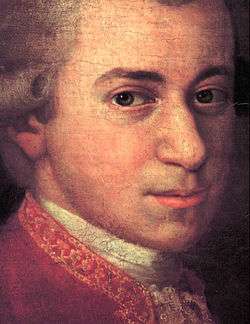Quintet for Piano and Winds (Mozart)
The Quintet in E flat major for Piano and Winds, K. 452, was completed by Wolfgang Amadeus Mozart on March 30, 1784 and premiered two days later at the Imperial and Royal National Court Theater in Vienna.[1] Shortly after the premiere, Mozart wrote to his father that "I myself consider it to be the best thing I have written in my life."[1] It is scored for piano, oboe, clarinet, horn and bassoon.
Structure and Analysis
There are three movements:
- Largo - Allegro moderato, 4/4
- Larghetto in B flat major, 3/8
- Allegretto, 2/2
This structure closely resembles that of a typical sonata. The first movement is a sprightly sonata form Allegro, with themes being passed from instrument to instrument, usually with the piano introducing a theme and accompanying while the oboe, clarinet, horn and bassoon play variations on it. The Larghetto movement is typical of the 2nd movement of other Mozart pieces: soft and gentle, yet still engaging. The Allegretto movement is a "sonata-rondo" of the kind Mozart used as the finale of many of the piano concertos he was writing at this period, and contains a written-out cadenza-like section toward the end.
This piece was allegedly the inspiration for the Quintet in E flat for Piano and Winds, Op. 16, by Ludwig van Beethoven, who composed this tribute in 1796. Both compositions use the same scoring.
Media
 |
Quintet for Piano and Winds
1. Largo – Allegro Moderato
2. Larghetto
|
| Problems playing these files? See media help. | |
References
- Notes
- 1 2 Berger 2001, pp. 299–300
- Sources
- Baron, John Herschel (1998). Intimate Music: A History of the Idea of Chamber Music. Stuyvesant, New York: Pendagon Press. ISBN 9781576471005.
- Berger, Melvin (2001). Guide to Chamber Music. Mineola, New York: Dover. ISBN 0-486-41879-0.
- Zajkowski, Roberta (2010). The Piano and Wind Quintets of Mozart and Beethoven: Reception and Relationship (D.M.A). Ohio State University.
External links
- Quintett in Es fur Klavier, Oboe, Klarinette, Horn und Fagott KV 452: Score and critical report (German) in the Neue Mozart-Ausgabe
- Quintet in E-flat major, K.452 (Mozart, Wolfgang Amadeus): Scores at the International Music Score Library Project
